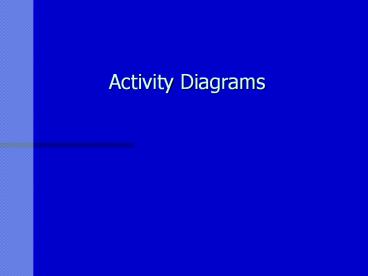Activity Diagrams - PowerPoint PPT Presentation
Title: Activity Diagrams
1
Activity Diagrams
2
Introduction
- An activity diagram...
- Models the dynamic aspects of a system.
- Serves the same function as a flowchart.
- Is composed of a sequence of activities, possibly
concurrent. - An activity is an ongoing non-atomic execution
within a state machine. - Each activity generates actions.
- Actions are atomic computations that result in a
change of state or the return of a value. - Is commonly used to show the activities involved
in carrying out a particular use-case.
3
Terms and Concepts
- An activity diagram
- Shows the flow from activity to activity.
- Is graphically rendered as a collection of
vertices and arcs. - Commonly contains activity states, action states,
transitions and objects.
4
Terms and Concepts
5
Terms and Concepts
- An action state
- Represents an atomic computation that takes an
insignificant amount of time. - Cannot be decomposed.
6
Terms and Concepts
- An activity state
- Represents a computation that can be decomposed
into other activities and actions. - Is not atomic.
- Takes some duration to complete.
- Is graphically rendered the same as an action,
but may contain entry and exit actions.
7
Terms and Concepts
- A transition
- Shows the path between activity and action
states. - Is graphically represented as a directed line.
8
Terms and Concepts
- Branching
- Is used to show alternate flows of control.
- Is represented as a diamond. Outgoing
transitions are labeled with Boolean expressions
9
Terms and Concepts
- Forking and Joining
- A fork is when a single flow of control splits
into two or more parallel (concurrent) flows of
control. - A join is when two or more flows of control merge
into a single flow of control. - A flow of control is also known as a thread.
- A synchronization bar is used to model forking
and joining, and is modeled as a thick horizontal
or vertical bar.
10
Terms and Concepts
11
Terms and Concepts
- Swimlanes...
- Are used to group activities according to the
organization responsible for those activities. - Are eventually implemented by one or more
classes. - Are divided by solid vertical lines.
- Can be used in the context of concurrency.
- An activity can only belong to one swimlane, but
transitions between activities may cross
swimlanes.
12
Terms and Concepts
13
Terms and Concepts
- Object Flow
- Objects may be attached (using dependencies) to
specific activities in an activity diagram. - The activity to which an object is connected has
a direct effect on the objects state or
lifetime. - An objects state may be shown in brackets inside
the object rectangle.
14
Terms and Concepts
15
Common Modeling Techniques
- Use activity diagrams in the same situations you
would use flowcharts - to model operations and
work flows. - Feel free to insert actors and objects into your
activity diagrams to show which activities they
are directly involved with. - You can attach activity diagrams to classes,
interfaces, components, nodes, use cases and
collaborations

